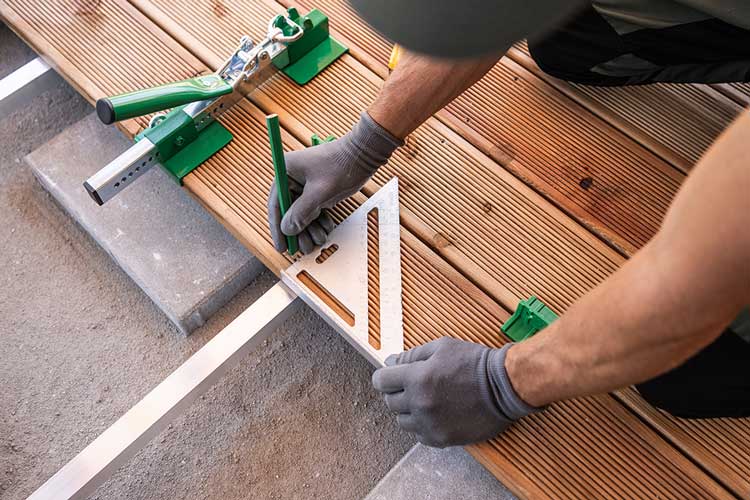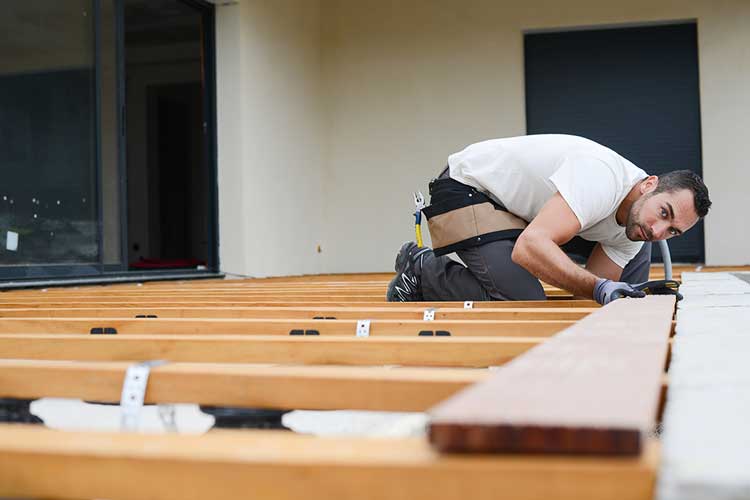Last updated November 2025

Build (or rebuild) a deck off of your home, and you’ll have a spot for al fresco entertaining, grilling, or just chilling with a book. But it takes a lot of planning and money to create one, whether you hire a local business or—for the super-handy only—put one in yourself.
Here’s what to consider.
What Kind of Deck?
The size and type of your home often dictates the sort of deck you need. But for most homes, these outdoor spaces tend to be either the same width or slightly less wide than the structure they serve. You don’t want a deck that dwarfs your house—a 20,000-square-foot deck would look ridiculous on your 1,500-square-foot bungalow. Want a second floor over your first-floor outdoor space or a small balcony? A deck builder can execute those, too.
If you already have an older deck with visible signs of rotting wood or sagging supports, you might need to replace it. “People don’t always understand that decks have a life cycle, like roofs,” said Michael Beaudry, executive vice president of the North American Deck and Railing Association, a nonprofit membership association offering education and credentialing to industry members. “It’s usually a question of repair or replace.”
Decking materials range from pressure-treated lumber (least expensive) to pricier composites (recycled wood and plastic like Trex, Fiberon, and TimberTech) to expensive wood species like cedar, redwood, or teak. A decking contractor can also show you samples and go over factors such as durability and cost.
You can check out Consumer Reports’ ratings of decking materials to compare prices, features, and maintenance. The big advantage of going with composite materials is that they’re maintenance-free. But they’re pricier and less attractive than wood.
“Wood is still very popular and probably accounts for 70 percent of the decks built in this country,” Beaudry said. “Your costs go up significantly with some of the composites and more exotic woods.”

Layout Considerations
Your yard’s size, elevation, drainage, and tree cover will greatly affect how you lay out and design your deck. If your outdoor space slopes, a multi-level deck can step down with your yard. If existing trees don’t shade your deck, you can kit it out with a pergola, awning, or other way of shielding yourself from the sun.
Don’t forget about what’s next door: if your neighbors can see into your yard, you might angle the deck differently or install a privacy hedge just off the deck.
Most decks are rectangular or square, but they can be almost any shape you’d like, including triangular or round.
The deck can be accessible solely through the house (good if you have space for a deck over a parking pad) or you can have one or more staircases connecting the deck to your yard.
Construction and Permitting Matters
Building a new deck is as much an engineering job as a construction one. If you’re installing a new one, in most areas it’ll need to be permitted and inspected, and you might consider hiring an architect or landscape architect to help with the plans.
It takes engineering and knowledge of load-bearing principles and building materials to create a safe, stable deck. The grade of the wood or composite material, the spacing of the joists, beams, and posts, and the overall design of the deck impacts how much weight it’ll hold and whether it’s suited for your Top Chef-worthy outdoor kitchen. If you cheap out, you might find yourself with a collapsing structure that won’t pass inspection.
“It’s important to think about what you want on your deck—a hot tub, seating for a bunch of people,” Beaudry said. “A good deck builder tends to overbuild, using two-by-eight boards when the project only calls for two-by-sixes.”
Most decks are designed to support 60 pounds per square foot including the weight of the deck (the “dead load”) as well as whatever people and things you put on it (the “live load”). Looking to host big bashes or add a hot tub? You’ll need extra support for safety.
Unlike minor outdoor projects, decks require adhering to local building and safety rules and regulations. These range from HOA size limits to setback distances or structural requirements set by your city, town, or even neighborhood. The height of railings and the placement of and pitch of stairs may also be dictated by local code.
“I was surprised, when I decided to build a deck off of my rowhouse, how long the process took,” said Jill Gerber, a content strategist in Washington, D.C., who recently completed her project. “From the first piece of paper I signed till the final nail, it took three years due to pandemic-related material delays and a size variance I sought from the city.”
Don’t hire a deck builder unless the company will navigate the permitting process for you. Consider getting a copy of the building codes for decks for your area and then compare requirements with specs provided by prospective contractors.

How to Find a Deck Builder
Some companies specialize in just decks. Many general contractors, fence builders, and carpenters also build decks, but sometimes only as part of larger projects. Here at Checkbook.org, you’ll find consumer reviews for all these types of services. But if you want a complete replacement of an existing deck or need a brand new deck, you might as well go with a company that specializes in them. A good deck-building outfit should not only be up on the latest materials and building codes in your area, it also should be able to smooth the permitting and inspection process.
Seeking a new deck design? Consider hiring an architect or landscape architect to draw up a plan that you then have a deck builder execute.
There’s no formal training required to be a deck builder. Industry group the North American Deck and Railing Association requires all members to be licensed and insured in their localities and also offers educational opportunities for its members. Being a member of the organization doesn’t guarantee good work, but it suggests an interest in and adherence to some industry standards. Its directory may be a good place to start looking for pros, but you should also consult customer reviews here at Checkbook.org; many great contractors don’t bother joining professional associations.
Check out companies’ online portfolios so you know if you’ve got a backyard oasis specialist or just a couple of guys with some two-by-fours.
Once you’ve identified some possible contractors, ask them lots of questions. Go over your plans and ideas with them, and ask about their experience with your type of job. These conversations will likely provide you with lots of new ideas.
Get references and check them. Ask past customers if the company gave them money-saving solutions, if the work was as attractive and as well done as expected, whether it passed inspection on the first try, if the company stuck to its agreed-upon prices, and whether it minimized disruption to their lives.
To protect your finances against big damage claims, ask companies for proof that they carry general liability and worker’s compensation insurance.

Get a Solid Contract
Get at least three fixed-price bids; it’s the only way to make sure you don’t overpay. And don’t assume there’s any relationship between how much you spend and the quality of work. We find again and again that even the best home improvement contractors often charge low prices.
Get a formal contract in writing specifying payment terms, deadlines, and who will be doing the work. It should include the name, address, and phone number of customer and company, a highly detailed description of the work (preferably with drawings), including drawings of new deck plans, and details on building products—and specify that all materials will be new.
The contract should also include start and end dates, and a warranty on work and materials, preferably one lasting several years.
To protect against an obviously substandard job, insist that the contract include requirements that the company obtain and pay for necessary permits, and arrange for government inspections, if required. The contractor also should obtain approvals by any homeowners’ association or historic district.
And insist that the contract stipulate that the contractor will be responsible for scheduling and passing any needed inspections.
Arrange to pay as little as possible until the work is finished and you are satisfied. Avoid contractors that require large deposits or payment in advance. If your job requires a lot of materials, it’s reasonable to pay a deposit against these expenses. But paying for everything or almost everything at the end gives you the most leverage to get the work done properly.
Deal promptly with problems. Understand that no one can anticipate every possibility. If problems happen, work with your contractor to reach a solution.


